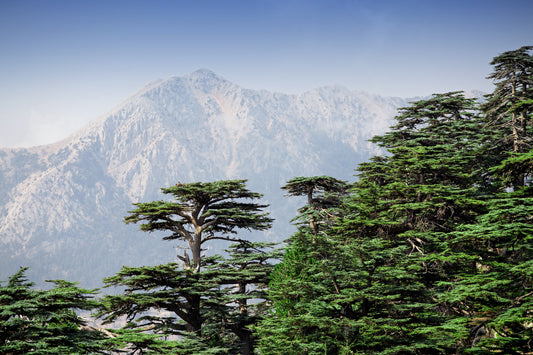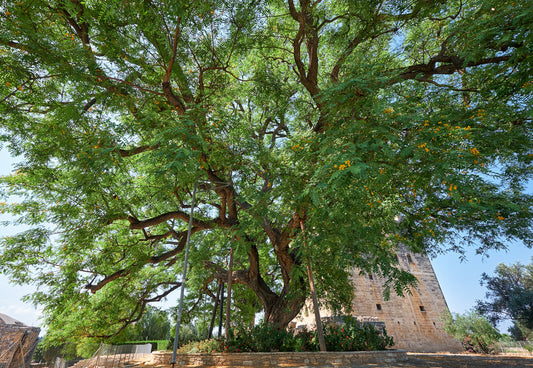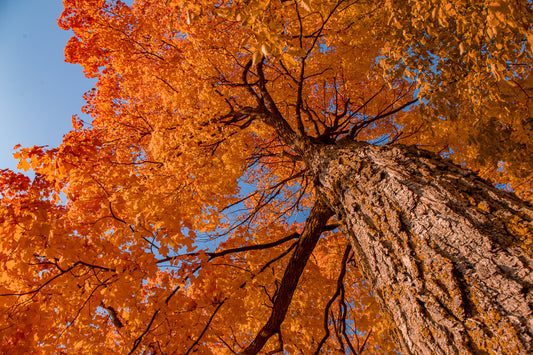Maple
Introduction
Maple trees, famed for their fiery fall foliage and the sweet sap they produce, have captured imaginations and crafted narratives across the world. Along with its vivid autumnal displays, maple is celebrated for its valuable timber. This versatile wood, known for its durability, fine grain, and warm tones, has been a favored material in design and architecture throughout history.

Designers and architects across eras and cultures have favored maple for its strength, longevity, and the innate elegance it imparts to the final piece. A prime example of the use of maple in design is the FENIS CM chair by Zanotta.

FENIS CM chair by Zanotta
Designed by Carlo Mollino in 1950, the FENIS CM chair features a flowing silhouette, inspired by the dynamism and grace of nature itself. The use of maple in this iconic piece was no accident. Maple's inherent strength and durability were essential to support the chair's intricate form, ensuring its elegance did not compromise its functionality.
The way Mollino brought together traditional craftsmanship and modern design mirrored the dual identities of the maple tree itself – deeply rooted in nature and cultural narratives, yet effortlessly fitting into contemporary design aesthetics.

FENIS CM chair by Zanotta
Beyond this marriage of natural and man-made, maple trees serve as significant symbols in many cultures, their leaves emblematic of strength, endurance, and the inevitability of change. The fiery colors of the maple leaf in fall have led to its association with transformation, offering a poignant metaphor for the cyclicality of life.
Just as Mollino's FENIS CM chair exemplifies the coming together of art, design, and functionality, the maple tree bridges the gap between our ancestral reverence for nature and our modern aesthetic aspirations. So let’s learn about this living beings that shape our interiors, both of our homes and our cultures.
The Maple Tree
Maple trees are a group of decidacious trees and shrubs belonging to the genus Acer. With approximately 128 known species, maples span a wide geographic range, primarily in the Northern Hemisphere. Upon hearing 'maple,' your first thought might have been "Maple trees, eh?" and pictured quintessential Canadians making ice lollies with their sap. But rest assured, maple trees don't hold passports or wear flannel! In fact, they thrive across North America, Europe, northern Africa, and Asia, highlighting the adaptability of these trees to diverse climatic conditions. Yes, the Canadian flag bears the iconic maple leaf, but the realm of the maples extends far beyond the Great White North!
Acer species vary widely in size, with some growing to formidable heights of up to 145 feet, such as the Sugar Maple, while others like the Japanese Maple remain relatively small and shrubby. The life span of a maple tree can be impressive, with some specimens known to live for more than 300 years.
Maple leaves, with their characteristic palmate shape, are perhaps one of the most recognized leaf forms in the plant kingdom. However, unlike the iconic red one we all know, the number of lobes on them can very, as can their shapes. Each leaf typically has three to nine pointed lobes, with serrated margins and pronounced veining. The diversity within the maple family is evident in the various leaf colors, which can range from rich greens to deep reds and even variegated forms.
In fall, the maple tree takes on its famed role as the harbinger of the season, its leaves transforming into a fiery palette of yellows, oranges, and reds. This dramatic change, spurred by the shortening days and cooler temperatures, draws visitors worldwide to regions known for their fall foliage, such as the northeastern United States and Canada.
Bark is another distinguishing characteristic of maples. Young trees generally have smooth bark that gradually furrows and flakes with age. The bark of different species varies in color from pale grey to dark brown. Some, like the Paperbark Maple, are known for their peeling, cinnamon-colored bark, which adds interesting sights to the winter landscape.
Maples produce distinct winged fruits called samaras, colloquially known as 'helicopters' due to their unique, spinning descent to the ground. These samaras contain the seeds of the maple and aid in their dispersal by wind.
The Maple Forest
Maples are more than just providers of timber and beautiful landscapes. They play a crucial role in the ecosystems they inhabit. And while they can be found in pure stands, more often than not they exist as a part of mixed forests, creating a vibrant mosaic of biodiversity.
These trees adapt well to different soil types, favoring moist, well-drained soils but capable of growing in varying conditions. They also show a broad range of tolerance for light, with some species like the Sugar Maple thriving in the shade, while others such as the Silver Maple prefer sunnier spots, complementing other forms of botanical life.
In the heart of these forests, a rich tapestry of life unfolds. Maples provide shelter and food to an array of creatures. Their nectar-rich flowers are a valuable food source for insects, including bees and butterflies, which in turn pollinate the flowers, ensuring the next generation of trees.
The samaras not only provide a unique mode of seed dispersal but also serve as nourishment for many wildlife species. Squirrels, for example, are particularly fond of these seeds, and they often store them in their caches for the winter months. In a delightful twist of ecology, these cached seeds often germinate and grow into new trees, thus aiding in the propagation of the species.
Birds, too, find a safe haven amidst the branches of the maple. Songbirds and woodpeckers are frequent residents, the former enjoying the protection offered by the dense foliage, and the latter often drilling into the bark in search of insects. The cavities left behind by woodpeckers then provide homes to other species, including owls and bats.
Maples also offer a fascinating world for fungi, especially those that form a symbiotic relationship with the trees. These mycorrhizal fungi wrap around the roots of the maple, helping the tree absorb nutrients while receiving sugars in return. This mutually beneficial relationship showcases the intricate network of life in a maple forest.
A curious ecological phenomenon can be observed in Sugar Maple forests where earthworms are absent. These forests have a thick layer of leaf litter, as the slow-decaying leaves of the Sugar Maple create an environment hostile to earthworms. The leaf litter provides habitat for a host of ground-dwelling creatures, including salamanders and numerous insects, highlighting the maple's role in shaping the forest floor's ecology.
The ecology around maples also extends to larger fauna. In forests where they are prevalent, deer often browse on the young shoots and leaves of maples. The larger Sugar Maples are known to provide denning sites for black bears, further attesting to the crucial role these trees play in maintaining biodiversity.
And while we all know that leaves turn orange or red during fall (or autumn, depending on your preference), do you know the name of this phenomenon? The autumnal color change in maples is known as senescence, where chlorophyll breaks down, revealing the bright pigments hidden underneath. While a spectacle to behold, this change serves a functional purpose too. The process helps the tree recover nutrients from the leaves before they fall, an ecological strategy ensuring the tree's survival through winter.
Not only do maples orchestrate a magnificent autumnal ballet, but they also play a pivotal role in maintaining the stability and health of their habitats. The extensive root systems of these trees grip the soil firmly, preventing erosion and landslides. In this way, they protect the physical integrity of the forests they inhabit.
Moreover, as towering members of the forest canopy, maples participate actively in the water cycle and are a key element of local climate regulation and the broader carbon cycle. They consume carbon dioxide for photosynthesis, effectively acting as carbon sinks. In other words, they capture and store excess carbon, helping to mitigate the impacts of climate change, one leaf at a time.
It is this remarkable blend of beauty, resilience, and ecological significance that underscores the maple's cultural resonance across the world.
Cultural Significance of Maples
The cultural roots of the maple tree run deep, spreading across continents and civilizations, intertwining with the lives of humans in meaningful and multifaceted ways. Its distinct form, the emblematic leaves, and the seasonal transformation it undergoes all serve as potent symbols in cultural narratives worldwide.
In the Far East, the maple tree plays a significant role in heralding the arrival of autumn, a season filled with festivals and events. The Japanese observe "momijigari", a traditional custom of viewing the changing autumn leaves, particularly of the maple tree, which literally translates as “maple leaf hunting”.
Similarly, in Korea, people gather in places like the Naejangsan National Park to celebrate the brilliant display of autumn colors with Chrysanthemum pancakes and yuja tea, a festival termed "danpung-nori". The beautiful colors of the maple leaves during these periods serve not only as a visual feast but also as a reminder of the impermanence of life and the passage of time.
In North America, several Native American tribes have had a profound connection with the maple tree, recognizing it as a valuable resource and celebrating it in their traditions. Among these tribes, the Ojibwe, Anishinaabe, and the Haudenosaunee (or Iroquois) of the northeastern United States and eastern Canada stand out for their longstanding maple traditions. For these tribes, the maple tree is not merely a part of the landscape but a life-sustaining entity, its sweet sap providing an essential source of nutrition. They have perfected the art of tapping the maple trees in a sustainable manner, a skill passed down through generations. It is more than a survival skill; it's a tradition that has helped bond communities to this day, serving as a testament to human resourcefulness and the tree's life-sustaining gifts even in the face of the upheavals of colonization.
This reverence for the tree resonates strongly in Canada. Here, the maple leaf holds a central position in the nation's identity, embossed on the Canadian flag as a potent symbol of unity, tolerance, and peace. With the arrival of spring, many Canadians partake in 'sugar bush' parties, festive celebrations marking the maple syrup harvest season - the end of winter and the advent of spring.
Maple Tree Conservation and Threats
Despite their cultural impact and their resilience and adaptability, maple trees aren't invincible, and they face serious threats due to environmental changes, human activities, as well as certain pests and diseases. Their conservation is a concern that spans the globe, as the health and prevalence of these trees are intrinsically tied to the ecosystems they inhabit and the cultures they influence.
Climate change poses an alarming threat to maple trees. As temperatures rise and rainfall patterns shift, this can significantly affect the growth rates and distribution of maples, in turn impacting their health and longevity. The sugar maple, known for its sap, is particularly vulnerable to climatic alterations. If conditions continue to grow warmer and drier, this could inhibit sap flow and compromise syrup quality, dealing a blow to the maple syrup industry and the communities that depend on it.
Moreover, various pests and diseases also menace the health of maple trees. Invasive species such as the Asian Longhorned Beetle can inflict considerable harm upon maple populations. These beetles bore into maple trunks, weakening the trees over time and eventually leading to their death. In a similar vein, fungal and bacterial diseases like Verticillium wilt, tar spot, and anthracnose can threaten maple health, leading to leaf drop, wilting, and even tree mortality in severe instances.
The urbanization process represents another challenge for maple trees. The conversion of natural habitats into infrastructure often leads to the destruction of mature maple trees. While urban settings frequently feature maple plantings due to their aesthetic value, these environments might not provide the intricate ecosystem interactions needed for the trees' optimal health and longevity.
Nonetheless, efforts to conserve and protect maple trees, and the ecosystems they nurture, are in progress. Various conservation programs are emphasizing the preservation of mature maples, promoting sustainable harvesting practices for maple syrup, and conducting research on disease resistance. Arborists and foresters that use both modern science and traditional knowledge are integral to these initiatives, providing expert care for these trees, treating diseases, and managing pests. In addition, citizen science initiatives are raising awareness about the importance of maples, thereby encouraging the public to participate in their conservation.
Conclusion
The value of the maple tree extends far beyond its aesthetic appeal or the quality of its timber. It is a keystone species, an integral part of ecosystems, and a rich cultural icon. More than that, it serves as an invaluable resource for many communities. Its strength and beauty are exemplified in crafted items like the elegant FENIS CM chair, showcasing the unique qualities of maple wood.
By creating unique pieces like the FENIS CM chair from sustainable sources, we not only harness the utility of the maple tree but also celebrate its beauty and resilience. Each piece of maple furniture is proof of the tree's life, the grain pattern, formed by the tree's annual growth rings, revealing the climatic conditions it encountered, the seasons it weathered, and the years it stood tall against time.
These objects remind us of our responsibility to protect and sustain the natural world that provides us with such gifts. It is then our duty to cherish them and protect the living world they were once a part of.
Article by: Andrei Mihail, see more about the author here




